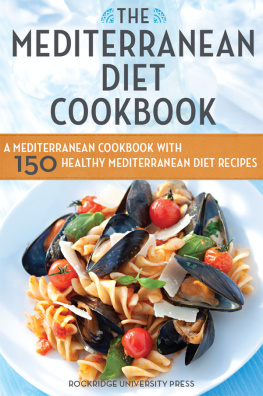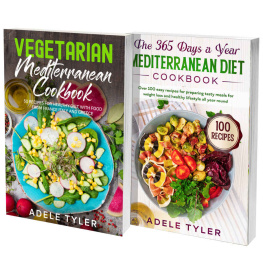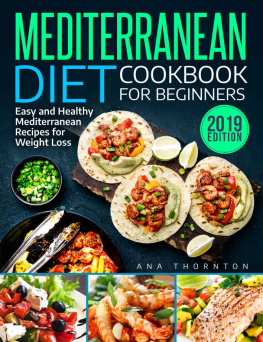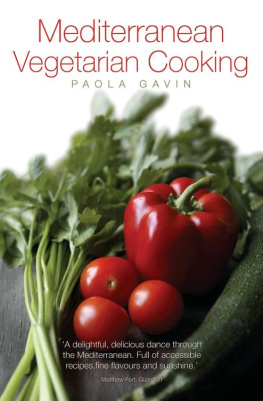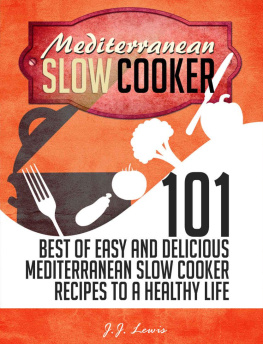T his book is about simple, easy to prepare Mediterranean vegetarian food. I like fast, fresh food, made with good quality ingredients food that tastes of what it is and is above all, healthy.
Mediterranean vegetarian food is probably the healthiest and most delicious in the world. It is traditional, peasant food passed on from parent to child for generations. It is based on pulses and grains, an abundance of fresh fruit and vegetables, nuts and seeds and a small amount of dairy produce. Extra virgin olive oil is the main cooking medium, and wine except in Muslim countries is usually served with meals. Meat has always been a luxury around the Mediterranean and only eaten on Sundays or for special occasions.
Each of the fifteen or so countries around the Mediterranean has its own unique culture and cuisine, but they all share the same climate, geography, vegetation, and lifestyle. In other words the same food is prepared from one end of the Mediterranean to the other. Of course each country has its own specialties and ways of preparing food, but everywhere you will see the same ingredients. In every open air food market in the Mediterranean you will find huge bunches of fresh herbs and greens spinach, Swiss chard, purslane, parsley, rocket, coriander, mint, oregano and basil plus strings of garlic and onions, all kinds of olives and an abundance of fresh fruit peaches, apricots, plums, nectarines, cherries, apples, pears, strawberries, grapes and all kinds of melons and citrus fruit.
In recent years much has been written about the benefits of the Mediterranean diet and how it lessens the risk of heart disease, cancer and other chronic diseases. The same can be said for the vegetarian diet. Put the two together and you have a recipe for good health.
The recipes I have chosen for this book are my own personal favourites that I have collected over the years while living and travelling around the Mediterranean. Most are very simple and easy to prepare. No great culinary skill is necessary. Mediterranean cooking is based on home style, peasant cooking. I hope the recipes evoke for you, as they do for me, the spirit of the Mediterranean.
| LIQUID MEASURES |
| Fluid Ounces | American | British(Imperial) | Millilitres |
| 1 teaspoon | 1 teaspoon | 5 |
| 2 teaspoons | 1 dessertspoon | 10 |
| 1 tablespoon | 1 tablespoon | 14 |
| 1 | 2 tablespoons | 2 tablespoons | 28 |
| 2 | cup | 4 tablespoons | 56 |
| 4 | cup | 110 |
| 5 | pint | 140 |
| 6 | cup | 170 |
| 8 | 1 cup | 225 |
| 9 | 250 |
| 10 | 1 cups | pint | 280 |
| 12 | 1 cups | 340 |
| 15 | pint | 420 |
| 16 | 2 cups | 450 |
| 18 | 2 cups | 500 |
| 20 | 2 cups | 1 pint | 560 |
| 24 | 3 cups | 675 |
| 25 | 1 pints | 700 |
| 27 | 3 cups | 750 |
| 30 | 3 cups | 1 pints | 840 |
| 32 | 4 cups or l quart | 900 |
| 35 | 1 pints | 980 |
| 36 | 4 cups | 1000 (1l) |
| 40 | 5 cups | 2 pints | 1120 |
SOLID MEASURES
|
| IMPERIAL | METRIC |
| Ounces | Pounds | Grams | Kilos |
| 1 | 28 |
| 2 | 56 |
| 3 | 100 |
| 4 | 112 |
| 5 | 140 |
| 6 | 168 |
| 8 | 225 |
| 9 | 250 |
| 12 | 340 |
| 16 | 1 | 450 |
| 18 | 500 |
| 20 | 1 | 560 |
| 24 | 1 | 675 |
| 27 | 750 |
| 28 | 1 | 780 |
| 32 | 2 | 900 |
| 36 | 2 | 1000 | 1 |
| OVEN TEMPERATURES |
| Fahrenheit | Celsius | Gas Mark |
| 225 | 110 |
| 250 | 130 |
| 275 | 140 | 1 |
| 300 | 150 | 2 |
| 325 | 170 | 3 |
| 350 | 180 | 4 |
| 375 | 190 | 5 |
| 400 | 200 | 6 |
| 425 | 220 | 7 |
| 450 | 230 | 8 |
| 475 | 240 | 9 |
Our destination, the isle of Rab, lay before us, the mountains bare as Krk, its shores green as spring But the scent of myrtle and rosemary and thyme was as strong and soothing a delight as sunshine.
Rebecca West, Black Lamb and Grey Falcons:
A Journey Through Yugoslavia
Land of Albania let me bend mine eyes on thee, thou rugged nurse of savage men!
Lord Byron, Childe Harolds Pilgrimage,
Canto 11, Stanza XXVIII
Croatia and Albania
I STRIA LIES IN THE north-east corner of the Adriatic where the Apennine and Balkan peninsulars meet. Most of Istria is part of present-day Croatia, except for the far north which belongs to Slovenia. Istrias strategic position at the gateway to the Adriatic has made it a battleground for invading peoples for much of its history. Around 900 B . C . Istria was inhabited by an Illyrian tribe the Histri who gave Istria its name. Istria flourished under the Romans as an important trade centre, exporting Balkan olive oil, wine and walnuts to other parts of Europe. In the centuries that followed the fall of the Roman Empire, Istria was overrun by the Visigoths, Huns, Slavs, Franks, Germans and Austrians. From the fifteenth century it was divided between Venice and Austria. It was the Venetians who first introduced foodstuffs from the New World haricot beans, pumpkins and squash. (Corn was not introduced until the seventeenth century, via Egypt, Romania and Hungary.) Venetian rule lasted nearly 400 years until Napoleon conquered Venice in 1797. After Napoleons defeat at Waterloo in 1815, Istria became part of the Austro-Hungarian Empire until the end of World War I. In the shake up after the war Istria was handed back to Italy, where it was incorporated into the province of Venezia-Giulia. It was not until the end of World War II that Istria was finally united with the Kingdom of the South Slavs or Yugoslavia. Even today, most Istrians speak Italian and retain strong cultural links to Italy.
Istrian cooking is a mix of Italian and Central European cuisines. All kinds of pasta dishes are made, especially krafi and zlikofi (ravioli) and fui (homemade noodles). Fui are often served with truffles, which are found in the region around Koper (Capodistiria) in the north-west. Istrians are also fond of thick vegetable soups similar to Italian minestroni that usually include potatoes, cabbage, herbs, dried beans or chickpeas, pasta or barley.



